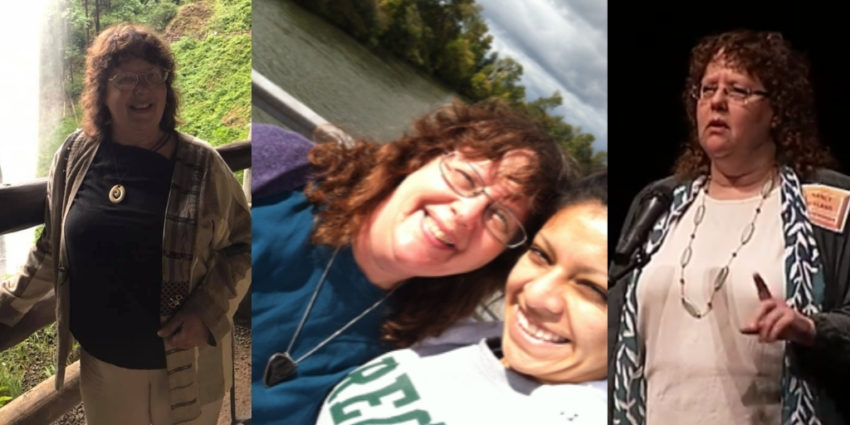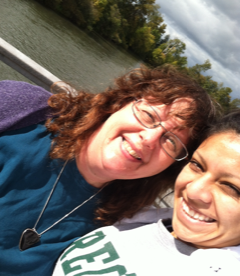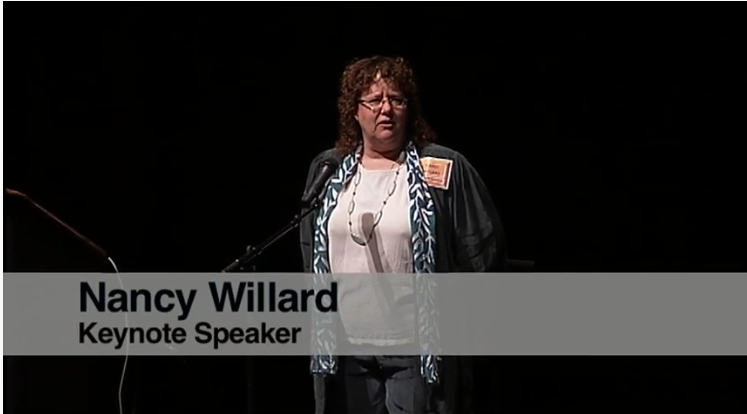
Share On Social!
Nancy Willard knows that the way educators are taught to handle bullying isn’t working, especially when it comes to cyberbullying.
That’s why she’s written several books on bullying prevention and digital safety, including the first book ever published on cyberbullying.
Willard is a former attorney and special education teacher in Veneta, Oregon who has dedicated her career to empowering students and families to stand up to bullies. She also taught those empowerment skills to her adopted Guatemalan daughter.
Now she wants to help schools build more culturally relevant anti-bullying programs, especially when the COVID-19 pandemic ends and more schools return to in-person learning.
A Background in Computer Law and Special Education
Before working on building student empowerment to stop bullying, Willard worked in special education and law.
As a special education teacher, Willard taught students with disabilities and emotional challenges who were often at risk for bullying.
Interested in digital safety and computer law, Willard obtained a law degree from Willamette University College of Law and became a practicing attorney in Oregon. She often served as an expert witness to cases related to discriminatory harassment. This gave her an understanding of laws and regulations related to bullying and harassment.
Willard then transitioned to a career as an educational technology and digital safety consultant, speaking at workshops and conferences about the importance of digital safety for children and teenagers.
Willard is also an author of several books on the topic, including Cyberbullying and Cyberthreats: Responding to the Challenge of Online Social Cruelty, Threats, and Distress; Cyber-Safe Kids, Cyber-Savvy Teens, Helping Young People Use the Internet Safety and Responsibly; and Cyber Savvy: Embracing Digital Safety and Civility.
She became one of the first authors to discuss cyberbullying and the risk it poses to young people.
That was how she realized that the anti-bullying programs educators are meant to follow don’t help for cyberbullying.
“I function in a way that is really strongly focused on what the research says. And when I wrote the book on cyberbullying, there obviously wasn’t any research. So I went to the research on bullying, and the guidance to educators both then and now on how to address bullying. And I said, ‘Oh my God, there’s a disconnect here,’” Willard said.
Willard is now focused on preventing and responding to bullying by teaching students to be empowered and resilient.
She published her latest book, Be Positively Powerful: A Guide for Teens on Achieving Resilience and Empowerment, in December 2019. It was recently translated to Spanish.
Now she wants to schools to adopt the suggestions from her book to make sure educators are equipped handle bullying.
Adopting her Daughter from Guatemala
Willard’s experience with being a parent – and being raised by an empowered mother – taught her a lot about personal empowerment and bullying.
“I raised by a mother who was one of two women in her graduating class in chemical engineering and fought for women’s liberation as I was growing up. So I don’t have a subservient attitude, as some women in my generation do,” Willard said.
When she adopted and raised a daughter from Guatemala, Willard instilled those same values in her.

“I was unable to raise her culturally as Latina. She was raised culturally by a woman who is in the dominant culture, who is not subservient,” Willard said.
She quickly noticed her daughter, Ally, began to be treated differently because she saw herself as aligned with the majority rather than the minority.
People expected her to back down in the face of bullying.
“One incident is when she was in fifth grade, and there was a student who just moved from Mexico and was an English language learner. And my daughter Ally started being friends with her and she knew enough Spanish so that they could communicate to some degree. This little girl was being harassed by other students on the playground. And when Ally took her to the playground aid to report this, the playground aid was also dismissive and did not respond in an effective manner. So my daughter marched this new ELL student up to the office to show her how to file a complaint against both the other students and the staff member,” Willard said.
As her daughter Ally grew older, she continued to face discrimination, which can unfortunately have severe consequences for Latinos.
“It was both in high school and when she’s gone into work as a cashier. She was routinely harassed, and she didn’t take it. And frequently there was surprise that she wasn’t willing or subservient, wasn’t willing to take it and that she actually responded and complained. She did actually lose a job one time because she was being harassed by the husband of an officemate, who was a police officer who was extremely racist and would say racist things to her, and when she objected, she got fired,” Willard said.
The experiences her daughter faced led Willard to understand that teaching children how to stand up for themselves is part of the solution to bullying.
“That’s one of the things that has led me to realize that, to address the bullying issues, we have to focus on personal empowerment. We have to make sure that all young people are resilient and have a level of personal power that allows them both to stand up and not take it from another student who is being hurtful, and to also feel comfortable in reporting and saying, ‘Hey, this is not okay.’ Those issues of resilience and personal power are really important to me,” Willard said.
Why Current Bullying Prevention Programs Don’t Work
Willard wants schools to rethink how they address bullying, because current programs don’t work, she says.
“The whole approach to address bullying is that schools are supposed to create rules against bullying. And they’re supposed to tell students to report and they’re also supposed to supervise students. And then they’re going to investigate and impose consequences on the one who was hurtful and that’s supposedly going to change their behavior,” Willard said.
This structure is ineffective for cyberbullying, according to Willard.
“Schools aren’t making the rules for the sites or apps that young people are using. School staff aren’t present in digital communities. Even more than in school, young people aren’t reporting what’s happening online because they figure adults don’t really understand and are going to overreact to make things worse. Principals have a very challenging time investigating because they don’t understand the technologies. And if they impose discipline, there is a clear prospect of generating digital retaliation that is uncontrollable,” Willard said.
Another flaw with current bullying programs is that the stereotypical “bully” who educators look for doesn’t match the research, according to Willard.
“Educators are told that the young people who bully are those who are at risk and they are engaged in other bad behavior and they end up in prison. There’s a portion of young people who that describes; usually they are also being bullied and their actions are in response to being bullied. But more recently, the vast majority of students who bully are considered leaders. They are popular, they are athletes, the school staff looks up to them, they’re compliant to school staff,” Willard said.
Educators should be more aware of bullying as a determinant of status, according to Willard.
“Bullying is done for the purpose of achieving dominance and social status. Bullying is an act of privilege. I have the right to put you down, or I’m going to put you down to prove that I am superior to at a higher social status than you are. Unless and until we understand these dynamics of hurtful behavior and change the way in which schools are trying to address bullying, we’re not going to see any success,” Willard said.
Addressing bullying should not mean forcing a bully to apologize, because that could lead to retaliation from the bully, Willard says. Instead, educators should hold bullies accountable and focus on changing the environment while helping victims grow in resilience and empowerment.
“We need to have better strategies. The current restorative practices end up with a forced apology and of course, acceptance of the apology and followed by retaliation. It has to be restorative, but there’s got to be a level to hold these students accountable. We have to provide that remedying the harm to the student who’s targeted, that also has to include helping that student gain greater resilience and empowerment. But most of all, we’ve got to address the environment,” Willard said.

A group of students who stand up to bullies and are focused on spreading kindness can be much more effective at stopping bullying than teachers or administrators, according to Willard.
“What’s going to be essential to effectively address the environment is a focus on cultural competence, on stopping any staff’s hurtful behavior, and empowering a diverse team of students who have a long history of consistently being kind and stepping in to help, students who are focused on social justice,” Willard said.
Concerns and Challenges
Despite having the resources and research to back her up, Willard is struggling to get schools on the same page as her.
“I have to admit, I haven’t been very effective in getting connections with schools, but none of the other professionals in this field who I associate with are being at all effective either. So it’s a real significant challenge. And that challenge is going to get worse as we shift from remote instruction to students back in school. And that’s what’s really driving me and making me very nervous going into the next school year,” Willard said.
Willard is especially concerned that as schools transition back to in-person learning when the pandemic ends, it will be extremely difficult for students who have found an escape from bullying while at home.
She found that when she reached out to parents and teachers in a Facebook group, many were happy that students were thriving at home.
“It was the number of parents and students and teachers who said that the kids who experienced bullying and anxiety and had greater challenges at school were loving remote learning, because they were being successful. And that’s where I went, ‘Oh my God.’ This does not bode well for when they go back to school and those positive things that they were experiencing go away and they’re back in an environment that doesn’t support them,” Willard said.
She’s worried that the sudden change in environment might led to an increase in suicide, due to its correlation with bullying. For example, 17.2% of Latino students report being bullied at school and Latina high-schoolers are more likely to attempt suicide than their white peers (15.1% to 9.8%), according to a Salud America! research review.
“What I’m exceptionally concerned about is that we’re going to see a significant increase in suicide behavior and suicides when we get back to so-called ‘school as normal,’ because normal for 10 to 20% of students is painful, is hurtful, is ‘I don’t feel welcome here. I don’t feel safe here,’” Willard said.
The difficulty is warning schools of this issue when many schools continue to use state-led bullying programs that haven’t made a significant difference in decreasing bullying, according to Willard.
“How do I tell people that we have a problem? How do I help prepare people to address this problem? Because I know most educators really care. Teachers and classified staff really care, most principals really care. But they keep doing what they’re told to be doing, even though there’s no evidence it’s working. And how do we change that? And I have to admit, I haven’t figured that out yet,” Willard said.
What Teachers and Parents Can Do
What should teachers and parents do to teach children how to stop bullying?
Build resilience and personal empowerment, according to Willard.
“Everybody needs to help young people become resilient and empowered,” she said.
In Willard’s latest book, Be Positively Powerful: A Guide for Teens on Achieving Resilience and Empowerment, she outlines seven strategies to help young people become resilient and gain personal power.
The seven steps are to make positive connections, reach out to be kind, use your strengths, focus on the good, be mindful, keep your personal power, and think things through.
Along with encouraging students to take the seven steps, Willard suggests building student groups that can stand up to bullies.
“If we could encourage schools to engage a diverse group of students to focus on activities to support kindness, that could also help,” Willard said. “Hopefully even high school students, especially high school students who experienced bullying, want to say, ‘Hey, that’s not OK. It’s not going to happen.’ And hopefully, their allies in the dominant culture can say, ‘No, we’re not going to put up with this anymore.’”
It’s important for students who are in the mainstream and don’t experience bullying to stand with victims of bullying, according to Willard.
“We’ve got a lot of dominant culture teens, who are saying, ‘No, no more. Black Lives Matter. Latino Lives Matter. Native Lives Matter. LGBTQ Lives Matter. Students with Disabilities Lives Matter.’ That’s what we need the teens from the dominant culture to be saying to their school leadership,” Willard said.
Explore More:
Overcoming Harmful BiasesBy The Numbers
3
Big Excuses
people use to justify discriminatory behavior
This success story was produced by Salud America! with support from the Robert Wood Johnson Foundation.
The stories are intended for educational and informative purposes. References to specific policymakers, individuals, schools, policies, or companies have been included solely to advance these purposes and do not constitute an endorsement, sponsorship, or recommendation. Stories are based on and told by real community members and are the opinions and views of the individuals whose stories are told. Organization and activities described were not supported by Salud America! or the Robert Wood Johnson Foundation and do not necessarily represent the views of Salud America! or the Robert Wood Johnson Foundation.



